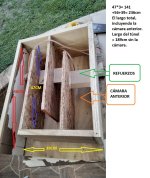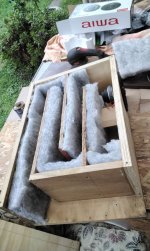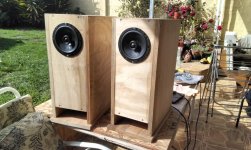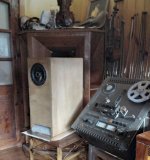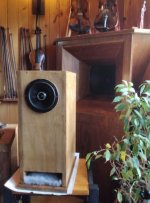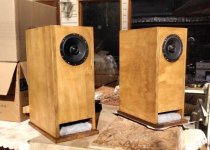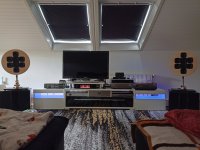Eclecticism is a term for my style of mish mashing things together when having company.

Last edited by a moderator:
I built a set of SEAS bookshelf speakers 25 years ago and recently got the bug to build something. So I gave the old faithful SEAS coax drivers a new home. After an aborted TQWT experiment, I ended up with this; a Dayton 8" HF subwoofer and Hypex plate amp on the back rounds out what I guess is a powered 3 way monitor? I also ended up with a lot of extra MDF, so built the ATMOS boxes on top with a little 3 inch full range in there.


May I post here my latest experiments?
OK. Thanks.
I built a pair of TL speakers for my best friend's birthday. With 92cm height X 39cm depth and 20cm internal width for a 16.5inch car coaxial, the AIWA AWs 1665p. Total lenght, including anterior chamber, is 3.6m! The cost for the transducers and for one MDF 15mm thick panel was around USD$ 55.-
They don't need a sub-woofer....they do need vertical reinforcement between internal panels, IMHO.
The result was so good (for a non-audiophile) that I built a smaller version (60cm) with 22mm plywood and total stuffing, instead of half tunel stuffing for the bigger one. Total length of the line, including the anterior chamber is 236cm...
Once we have the enclosures, we can later try better (more expensive) transducers.
I have found that those thin PMC TL sound thin/weak on the midbass, so I use an extra anterior chamber that works marvels and 20cm width. The sound is robust and ordered.
Cheers,
M.
OK. Thanks.
I built a pair of TL speakers for my best friend's birthday. With 92cm height X 39cm depth and 20cm internal width for a 16.5inch car coaxial, the AIWA AWs 1665p. Total lenght, including anterior chamber, is 3.6m! The cost for the transducers and for one MDF 15mm thick panel was around USD$ 55.-
They don't need a sub-woofer....they do need vertical reinforcement between internal panels, IMHO.
The result was so good (for a non-audiophile) that I built a smaller version (60cm) with 22mm plywood and total stuffing, instead of half tunel stuffing for the bigger one. Total length of the line, including the anterior chamber is 236cm...
Once we have the enclosures, we can later try better (more expensive) transducers.
I have found that those thin PMC TL sound thin/weak on the midbass, so I use an extra anterior chamber that works marvels and 20cm width. The sound is robust and ordered.
Cheers,
M.
Attachments
Sanded and varnished. ready to ship to my client....sorry, my Son, hehe.
I heard 32Hz...
The higher one may benefit from half-stuffing the final portion. It should render the sound more precise, though less fat.
I hope you like it. I like it a lot.
Cheers,
M
PS: I have to invent a "grille" to hide the poliester whool....
I heard 32Hz...
The higher one may benefit from half-stuffing the final portion. It should render the sound more precise, though less fat.
I hope you like it. I like it a lot.
Cheers,
M
PS: I have to invent a "grille" to hide the poliester whool....
Attachments
My main system is a space I built in a loft above my garage. It's fully horn loaded from 20->20K Hz with built in bass horns driven with VTL MB-125 mono amps and the 3-way mains driven with SET 300B amps with Western Electric 300B tubes.

System and room are built for analog playback. 3-way mains are fully time aligned. Due to the length of the bass horns there is a 5-6msec offset below ~65 Hz. In human hearing the small of an offset in that range is rarely perceptible, but digital time correction is not an option in a full analog system.
Front end currently includes my Super Nova Vacuum Platter TT with Triangle Art Osiris arm (table can also mount my SME type IV arm, but not currently mounted) and my BE 12C broadcast deck with Karmadon replica of the classic Gray research 108 viscous damped arm.
Phono stage is currently a Pro-Ject Tube box DS2 which is able to take multiple inputs and tunable for gain and loadings between MM and MC cartridges.
Pre amp is older Conrad Johnson Premier 17 that is upgraded with their teflon caps.
Power for the room is a couple of dedicated circuits with isolated grounding and additional power conditioning.

Main speakers include Cogent DS 1448 midbass and DS-1428 midrange field coil compression drivers and Fostex T-925a horn tweeters. Mains sensitivity is ~115db 1w/1m. Bass horns are built into the room and put out ~ 106 db 1w/1m below 80Hz down to 20 hz.


Room includes extensive millwork for diffraction. The record cases have upholstered backs with the space behind them stuffed with R-39 insulation: they are effectively bass traps. A heavy rug and some absorptive panels for first reflections and additional ceiling diffraction complete a room with very rapid decay times and few modes from reflections.
I cannot overstate how important good room treatment is for best playback. A well treated room will make mediocre equipment sound good while an unterted space can render the best equipment unlistenable.
System and room are built for analog playback. 3-way mains are fully time aligned. Due to the length of the bass horns there is a 5-6msec offset below ~65 Hz. In human hearing the small of an offset in that range is rarely perceptible, but digital time correction is not an option in a full analog system.
Front end currently includes my Super Nova Vacuum Platter TT with Triangle Art Osiris arm (table can also mount my SME type IV arm, but not currently mounted) and my BE 12C broadcast deck with Karmadon replica of the classic Gray research 108 viscous damped arm.
Phono stage is currently a Pro-Ject Tube box DS2 which is able to take multiple inputs and tunable for gain and loadings between MM and MC cartridges.
Pre amp is older Conrad Johnson Premier 17 that is upgraded with their teflon caps.
Power for the room is a couple of dedicated circuits with isolated grounding and additional power conditioning.
Main speakers include Cogent DS 1448 midbass and DS-1428 midrange field coil compression drivers and Fostex T-925a horn tweeters. Mains sensitivity is ~115db 1w/1m. Bass horns are built into the room and put out ~ 106 db 1w/1m below 80Hz down to 20 hz.
Room includes extensive millwork for diffraction. The record cases have upholstered backs with the space behind them stuffed with R-39 insulation: they are effectively bass traps. A heavy rug and some absorptive panels for first reflections and additional ceiling diffraction complete a room with very rapid decay times and few modes from reflections.
I cannot overstate how important good room treatment is for best playback. A well treated room will make mediocre equipment sound good while an unterted space can render the best equipment unlistenable.
Hi.
I built another TL with leftovers from my 22mm plywood. This time I used Focal Auditor RCX 165 car speakers (4 Ohm) first order filter for the tweeter, as you may know...
The tablet's mic is not that good, sorry.
I hope you like it.
M.
Dancing in the Field of Unlimited Potentials....
I built another TL with leftovers from my 22mm plywood. This time I used Focal Auditor RCX 165 car speakers (4 Ohm) first order filter for the tweeter, as you may know...
The tablet's mic is not that good, sorry.
I hope you like it.
M.
Dancing in the Field of Unlimited Potentials....
Last edited:
Good to see you are still always sawing something @maxlorenz. Nice album, nice car speaker pipes 🙂 If you don't mind, are those classic end-driven or offset?

Thanks very much for your interest in this wonderful speaker. Please go back to post #3763 and see my solution....the little one produces 32Hz and the bigger one, on the last post, reaches 28Hz....one bigger, 76cm tall can be fitted in just one MDF board....
Later, I will upgrade to better coaxials, likevFocal or other.
Cheers,
M.
Dancing in The Field of Unlimited Potential....
Later, I will upgrade to better coaxials, likevFocal or other.
Cheers,
M.
Dancing in The Field of Unlimited Potential....
modushop case with 3 hypex Nc400, faital drivers (15pr400, 10pr320, HF108 LTH102 horn), minidsp flex 8, old technics sl1200mk2 and a pcp picore player with display.
Custom cables made with vandamme microphone cable and 8-core speaker wire, neutrik speakon and xlr, switchcraft RCA for SE flex 8 output.
30mm birch ply finished with Osmo polyx natural.
If you hang a piece of black fabric off the back of your table, you can hide all the wires.
Open Baffle, active 3 way, 2 ripole with 4 Peerless 830845 12 inch woofers, round baffle each with 6 Dynavox (!) 4 inch midwoofers, mid/high covered by B&G Neo8S, x-over points L/R 24 db at 120 and 800 hz, I can use either digital active ( modified Behringer) or analog active X-over ( Thelaudio)
Using the Yamaha AVR as pre-amp only, diy streamer based on Rpi and Peppymeter.
Poweramps are Marantz amps, 6 x 140 watts at 8 ohm.
Although I am using ultra cheap Dynavox mid units, I love the open soundstage and incredibly tight bass coming from the set-up.
Using the Yamaha AVR as pre-amp only, diy streamer based on Rpi and Peppymeter.
Poweramps are Marantz amps, 6 x 140 watts at 8 ohm.
Although I am using ultra cheap Dynavox mid units, I love the open soundstage and incredibly tight bass coming from the set-up.
Attachments
Not only do I like the speakers and the room, but I also love the sky lights; I bet you have a good view of the night sky, thunder storms, and if you're very lucky the aurora borealis
Finished my passive stepped attenuator volume control last night, and acquired a serviced deck with new captive RCA cables incorporating grounding, and am enjoying this 60's AR XA with its included professionally installed Shure M55e. There's always something better, but I'm finding it hard to imagine there's a much better pairing than these two. Lots of goodies I love about this table. Lucky for me it didn't fit with the seller's wife's taste in room decor.

Last edited by a moderator:
- Home
- Loudspeakers
- Multi-Way
- System Pictures & Description

